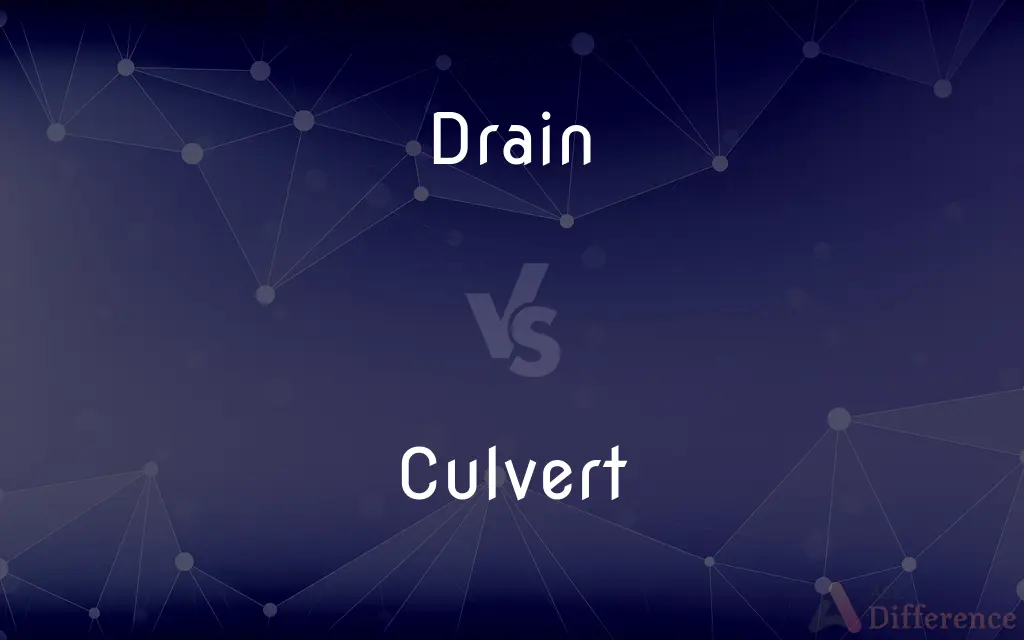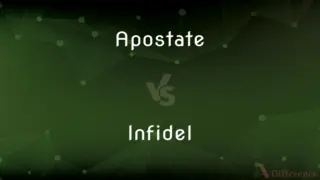Drain vs. Culvert — What's the Difference?
By Tayyaba Rehman & Urooj Arif — Updated on April 20, 2024
A drain removes water from surfaces and structures, mainly through channels or pipes; a culvert specifically channels water under roads and railways using pipes or enclosed channels.

Difference Between Drain and Culvert
Table of Contents
ADVERTISEMENT
Key Differences
A drain is designed to collect and channel water away from built-up areas to prevent flooding and waterlogging, whereas a culvert serves to enable water flow beneath structures like roads or railways without interrupting the passage above.
Drains can be open channels, like street gutters, or closed systems, such as underground pipes, while culverts are typically enclosed structures that might use materials like concrete, metal, or plastic.
In urban planning, drains are integral for managing stormwater within cities and towns, diverting water to larger sewage or water treatment facilities. On the other hand, culverts are crucial in civil engineering projects to maintain natural watercourses and prevent road erosion.
Maintenance requirements for drains often involve clearing debris and ensuring free flow of water to prevent back-up and overflow. Culverts, however, require inspections to ensure structural integrity and clearance from sediment and blockages.
Regulatory compliance for drains usually pertains to urban water management standards and pollution control, whereas culverts must adhere to environmental and transportation safety regulations to protect wildlife habitats and ensure structural safety under roads.
ADVERTISEMENT
Comparison Chart
Definition
A system for removing water from surfaces
A structure allowing water to flow under a road or railway
Location
Urban areas, inside buildings, along streets
Primarily under transportation routes like roads and railways
Materials
Concrete, metal, plastic, clay
Concrete, steel, plastic, stone
Maintenance Concerns
Debris removal, blockage clearance
Structural integrity, blockage clearance
Regulatory Focus
Water management, pollution control
Environmental impact, transportation safety
Compare with Definitions
Drain
A feature in software or systems that depletes battery life.
That app is a real drain on your smartphone's battery.
Culvert
A tunnel carrying a stream or open drain under a road or railroad.
The new culvert was installed to prevent the road from flooding.
Drain
A channel or pipe that carries off excess water.
The street drain was cleared to prevent flooding during heavy rain.
Culvert
A part of environmental engineering to maintain natural water pathways.
Environmentalists designed the culvert to support local wildlife.
Drain
A device to prevent overflow in basins and sinks.
She cleaned the sink drain to keep the water flowing smoothly.
Culvert
A structural feature designed to allow vehicle and pedestrian traffic to cross over water.
The culvert under the trail lets hikers pass over without getting wet.
Drain
A means of depleting resources or energy.
Constant repairs were a drain on his finances.
Culvert
A conduit made from metal, concrete, or plastic.
They used a large concrete culvert to redirect the creek.
Drain
The act of gradually decreasing something.
The scandal slowly began to drain the company's credibility.
Culvert
A preventative feature against erosion under roads.
Installing culverts along the new road helps reduce erosion during storms.
Drain
To draw off (a liquid) by a gradual process
Drained water from the sink.
Culvert
A culvert is a structure that allows water to flow under a road, railroad, trail, or similar obstruction from one side to the other. Typically embedded so as to be surrounded by soil, a culvert may be made from a pipe, reinforced concrete or other material.
Drain
To cause liquid to go out from; empty
Drained the bathtub.
Drain the pond.
Culvert
A tunnel carrying a stream or open drain under a road or railway.
Drain
To draw off the surface water of
The Mississippi River drains a vast area.
Culvert
Channel (a stream or drain) through a culvert
A culverted drain
We have asked for the river to be culverted
Drain
To drink all the contents of
Drained the cup.
Culvert
A sewer or drain crossing under a road or embankment.
Drain
To cause (a resource or supply of something) to be used up gradually and often completely.
Culvert
The part of a road or embankment that passes over such a sewer or drain.
Drain
To fatigue or spend emotionally or physically
The day's events drained me of energy.
Culvert
The channel or conduit for such a sewer or drain.
Drain
(Sports) To put (a ball or shot) into a hole or basket, as in golf or basketball
Drained the putt for a birdie.
Culvert
A channel crossing under a road or railway for the draining of water.
Drain
To flow off or out
Gasoline drained slowly from the tilted can.
Culvert
To channel (a stream of water) through a culvert.
Drain
To become empty by the drawing off of liquid
Watched the tub slowly drain.
Culvert
A transverse drain or waterway of masonry under a road, railroad, canal, etc.; a small bridge.
Drain
To discharge surface or excess water
The Niagara River drains into Lake Ontario. When flooded, the swamp drains northward.
Culvert
A transverse and totally enclosed drain under a road or railway
Drain
To become gradually depleted; dwindle
Felt his enthusiasm draining.
Drain
A pipe or channel by which liquid is drawn off.
Drain
(Medicine) A device, such as a tube, inserted into the opening of a wound or body cavity to facilitate discharge of fluid or purulent material.
Drain
The act or process of draining.
Drain
A gradual outflow or loss; consumption or depletion
The drain of young talent by emigration.
Drain
Something that causes a gradual loss
Interruptions that are a drain on my patience.
Drain
A conduit allowing liquid to flow out of an otherwise contained volume; a plughole UK
The drain in the kitchen sink is clogged.
Drain
An access point or conduit for rainwater that drains directly downstream in a (drainage) basin without going through sewers or water treatment in order to prevent or belay floods.
Drain
Something consuming resources and providing nothing in return.
That rental property is a drain on our finances.
Drain
(vulgar) An act of urination.
Drain
(electronics) One terminal of a field effect transistor (FET).
Drain
(pinball) An outhole.
Drain
A drink.
Drain
(intransitive) To lose liquid.
The clogged sink drained slowly.
Drain
(intransitive) To flow gradually.
The water of low ground drains off.
Drain
To cause liquid to flow out of.
Please drain the sink. It's full of dirty water.
Drain
To convert a perennially wet place into a dry one.
They had to drain the swampy land before the parking lot could be built.
Drain
(transitive) To deplete of energy or resources.
The stress of this job is really draining me.
Drain
(transitive) To draw off by degrees; to cause to flow gradually out or off; hence, to exhaust.
Drain
To filter.
Drain
To fall off the bottom of the playfield.
Drain
To drink.
Drain
To draw off by degrees; to cause to flow gradually out or off; hence, to cause the exhaustion of.
Fountains drain the water from the ground adjacent.
But it was not alone that the he drained their treasure and hampered their industry.
Drain
To exhaust of liquid contents by drawing them off; to make gradually dry or empty; to remove surface water, as from streets, by gutters, etc.; to deprive of moisture; hence, to exhaust; to empty of wealth, resources, or the like; as, to drain a country of its specie.
Sinking waters, the firm land to drain,Filled the capacious deep and formed the main.
Drain
To filter.
Salt water, drained through twenty vessels of earth, hath become fresh.
Drain
To flow gradually; as, the water of low ground drains off.
Drain
To become emptied of liquor by flowing or dropping; as, let the vessel stand and drain.
Drain
The act of draining, or of drawing off; gradual and continuous outflow or withdrawal; as, the drain of specie from a country; the project is a drain on resources.
Drain
That means of which anything is drained; a channel; a trench; a water course; a sewer; a sink.
Drain
The grain from the mashing tub; as, brewers' drains.
Drain
Emptying accomplished by draining
Drain
Tube inserted into a body cavity (as during surgery) to remove unwanted material
Drain
A pipe through which liquid is carried away
Drain
A gradual depletion of energy or resources;
A drain on resources
A drain of young talent by emmigration
Drain
Flow off gradually;
The rain water drains into this big vat
Drain
Deplete of resources;
The exercise class drains me of energy
Drain
Empty of liquid; drain the liquid from;
We drained the oil tank
Drain
Make weak;
Life in the camp drained him
Common Curiosities
Where are drains commonly found?
Drains are commonly found in urban areas, buildings, and along streets.
Where are culverts commonly installed?
Culverts are commonly installed under roads and railways.
What materials are used to construct drains?
Drains are constructed from materials like concrete, metal, plastic, and clay.
What is the main purpose of a culvert?
To allow water flow under structures like roads and railways without causing disruption.
How are culverts maintained?
Culverts require inspection and maintenance to ensure they are free from sediment and structurally sound.
What are the environmental considerations for culverts?
Culverts must be designed to minimize impact on wildlife and natural watercourses.
What is the main purpose of a drain?
To remove excess water from surfaces and prevent water accumulation.
How are drains maintained?
Drains are maintained by removing debris and ensuring the flow of water is not blocked.
What materials are used to construct culverts?
Culverts are made from concrete, steel, plastic, and sometimes stone.
How do drains and culverts differ in regulatory focus?
Drains focus on urban water management and pollution control, whereas culverts focus on environmental and transportation safety.
Share Your Discovery

Previous Comparison
Apostate vs. Infidel
Next Comparison
Continental vs. IntercontinentalAuthor Spotlight
Written by
Tayyaba RehmanTayyaba Rehman is a distinguished writer, currently serving as a primary contributor to askdifference.com. As a researcher in semantics and etymology, Tayyaba's passion for the complexity of languages and their distinctions has found a perfect home on the platform. Tayyaba delves into the intricacies of language, distinguishing between commonly confused words and phrases, thereby providing clarity for readers worldwide.
Co-written by
Urooj ArifUrooj is a skilled content writer at Ask Difference, known for her exceptional ability to simplify complex topics into engaging and informative content. With a passion for research and a flair for clear, concise writing, she consistently delivers articles that resonate with our diverse audience.
















































